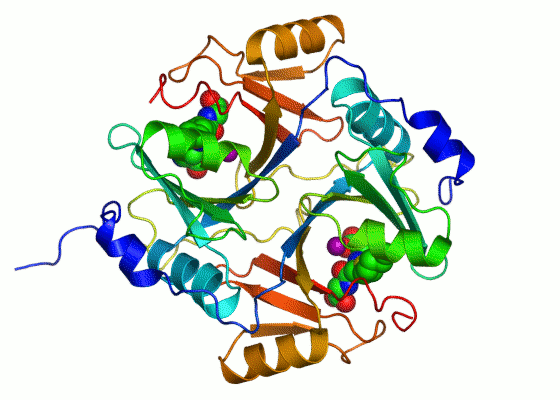What are Enzymes and how do they work?
Our body is an amazing factory. It performs all types of functions. These amazing functions are done by special parts of the body. One of the main parts that do the main function is the enzyme. An enzyme is nothing but a biological catalyst, having an irregular shape that speeds up the chemical reactions taking place in our body, such as in cellular respiration, breaking down the food products for producing energy. Even if the enzymes are not there in our body, chemical reactions would occur, but it may be slow. An enzyme does not require any energy to perform these activities. If one chemical reaction has been finished by an enzyme, the same enzyme can be reused for another chemical reaction. Every enzyme ends with a name called ase. The word before ase indicates what function they are doing. For example, an enzyme called Lactase converts the lactose present in the milk to small sugars like glucose and galactose.
 |
| Credit (Enzyme): By WillowW - Own work, CC BY 3.0, https://commons.wikimedia.org/w/index.php?curid=3599886 |
Enzymes are types of proteins that contain amino acids. There are 20 types of amino acids in our body that are actively converted into proteins. An enzyme contains thousands of amino acids. In order to perform a chemical reaction, two ingredients are essential. One is the catalyst, called an enzyme and the other one is a substrate, which may be the food we ate, that needs to be broken down for producing nutrients. In order for a successful combination between the enzyme and the substrate, there must be more substrate around an enzyme, moving at a specific speed to make the rightful combination with the enzyme. There are generally six groups of enzymes in our body based on their different functions. They are,
1. Oxioreductases (transfer electrons from one molecule to another)
2. Transferases (transfers the functional group of one molecule to another)
3. Hydrolases (breaks single bonds by adding water)
4. Lyases (breaks or combines double bonds)
5. Isomerases (a functional group is moved to another place within the cell)
6. Ligases (form single bonds by removal of water)
Each group of enzymes has several types of enzymes in it. Even though there are several types of enzymes in our body, they all share a few common characteristics. Each of these enzymes has an active site with them. This active site is different in shape for each enzyme. So each enzyme is unique for a specific substrate. So, in order for the chemical reactions to occur the enzyme must combine with a substrate. There are two types of theory, which state the combining of the substrate with the enzyme. One is the Lock and Key mechanism and the other one is Induced fit binding.
The lock and key mechanism theory state, that the enzyme and the substrate are fixed in shape. Such that, only a specific substrate combines with the specific enzyme. In induced-fit binding, the theory states that as the substrate gets near to the rightful enzyme, the enzyme automatically reshapes it to combine exactly with the coming substrate. So, that the substrate fits exactly in the enzyme. The combined pair is called the enzyme-substrate complex.
There are several factors that affect the chemical reaction performed by the enzymes. They are Temperature, pH, and the concentration of enzymes and substrates. If the temperature decreases in our body, the rate of movement of the substrate decreases, and the reaction will be slow. If the temperature increases too much, the reaction will be very fast. But the enzyme cannot withstand this temperature for a long time, leading to denature (changing the active site of the enzyme) of the enzyme. The pH of the environment of our body also decides the rate of chemical reaction performed by the enzyme. Each enzyme can operate only at a specific pH. For example, the enzyme present in the stomach called pepsin can operate in acidic and the enzyme present in the saliva called Amylase can operate in neutral, and the enzyme present in the blood called Alkaline phosphatase can operate in basic. If the pH level varies too much for any of these enzymes, the enzyme denatures and the reaction becomes slow. Also, if there is too much of substrate in a cell, the enzyme cannot operate all of these, and the reactions get slow. So overall, an enzyme combines with a substrate and breaks it down; or combines the functional group of a certain substrate, to release the product to speed up the chemical reactions. The graph below shows the energy utilized by a cell without and with an enzyme and the overall energy released with respect to the duration of the chemical reaction.
 |
Relationship between Enzyme and Reaction Coordinate. |
Written by [Jerine Victor]




Comments
Post a Comment